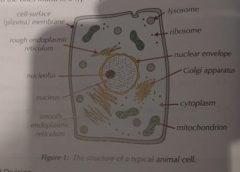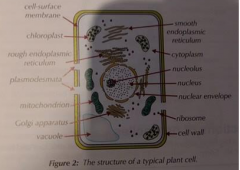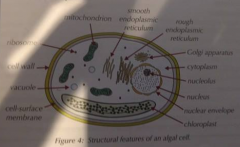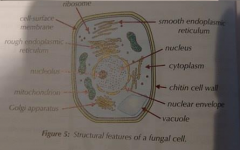![]()
![]()
![]()
Use LEFT and RIGHT arrow keys to navigate between flashcards;
Use UP and DOWN arrow keys to flip the card;
H to show hint;
A reads text to speech;
23 Cards in this Set
- Front
- Back
|
What is the difference between prokaryotic cells and eukaryotic cells? |
Eukaryotic cells are more complex and with other eukaryotic cells make eukaryotes where as prokaryotic cells make up the single celled prokarotes and are less complex, however both types contain organelles |
|
|
What are organelles? |
Organelles are part of cells which have a specific function for the cell |
|
|
What type of cells are eukaryotic cells? |
Plant, animal, algal, and fungal cells are eukaryotic cells |
|
|
What organelles are found in animal cells? |

Plasma-membrane, rough endoplasmic reticulum, lysosomes, ribosomes, nuclear envolope, nucleolus, nucleus, golgi apparatus, cytoplasm, mitochondrian, and smooth enoplasmic reticulum are the organelles found inside animal cells |
|
|
What organelles do plant cells have that animal cells don't? |

Cellulose cell wall which has plasmodesmata that are involved with exchanging substances between adjacent cells, vacuoles which are fluid filled compartments, and chloroplasts which are involved in photosynthesis |
|
|
What do algae and plants have in common? |
They both photosynthesize |
|
|
What makes algae cells different to plant cells? |
Their chloroplasts vary in shape and size, they can have one singular large chloroplast, algae can also take the form of unicellular organisms like chlorella or multicellular like seaweed |
|
|
What organelles do algae cells have? |

The same as plant cells |
|
|
What similarity do fungal cells have to algal cells? |
They can both be multicellular or unicellular |
|
|
What are the differences between the organelles in fungal cells and algal cells? |

Fungal cells have cell walls made of chitin and they have no chloroplasts |
|
|
Describe the cell-surface membrane/plasma membrane and say what its function is |
The cell surface membrane is found on the surface of animal cells and is mainly made of proteins and lipids, it controls the movement of molecules in and out of the cell, it also has receptor molecules on it |
|
|
Describe the nucleus and what its function is |
The nucleus is a large organelle that has a nuclear envolope surrounding it, the envolope has many pores in it, the nucleus contains chromosomes which are made of DNA and also one or more nucleolus's. The nucleus controls what the cell does as it has the DNA that is an instruction on how proteins are to be formed in a specific order, the pores in the envolope allows substances to move in and out |
|
|
Describe the mitochondrion and its function |
The mitochondrion is normally shaped like and oval, it has a double membrane and the inner one is folded giving it a large surface area, the inside of the mitochondrion contains enzymes involved in respiration. The mitochondrion is where aerobic respiration happens which produces ATP which is a common energy source for cells |
|
|
Describe the chloroplast and what its purpose is |
The chloroplast is small and flattened and is only found in plant/algal cells. Chloroplasts have a double membrane and has thylakoid membranes inside of it, the membranes stack up with each other to form grana which have large surface areas and are linked together by lamellae. Chloroplasts are where photosynthesis takes place, some parts of photosynthesis happen in the lamella and some in the stroma which is a thick fluid inside the chloroplast |
|
|
Describe and explain the function of the golgi apparatus |
The golgi apparatus is a group of fluid filled membranes and also has vesicles often on the edge of it, they process and package new lipids and proteins and also makes lysosomes |
|
|
Describe the golgi vesicle and how does it function? |
The golgi vesicle is a small fluid filled sac in the cytoplasm that is surrounded by a membrane and is produced by the golgi apparatus, the golgi vesicle stores lipids and proteins which are made by the golgi apparatus and transports them out of the cell |
|
|
What is a lysosome and how does it work? |
A lysosome is a round organelle surrounded by a membrane. It contains digestive enzymes called lysozymes which are used to digest invading cells or break down worn out components of the cell |
|
|
What does a ribosome do and what does it look like? |
Ribosomes are very small organelles that float freely in the cytoplasm or are attached to the RER. it is made of protein and RNA and performs protein synthesis. |
|
|
What does the RER do and also describe it |
The RER (Rough Endoplasmic Reticulum) is a system of membranes covered in ribosomes. Its purpose is to fold and process proteins made by ribosomes. |
|
|
What is the purpose of the Smooth Endoplasmic Reticulum (SER) and what does it look like? |
The SER has the same structure as the RER but it has no ribosomes. Its purpose is to synthesise ad produce lipids. |
|
|
What is the cell wall and how does it function? |
The cell wall is a rigid structure that surrounds plant, fungi, and algae cells. It is made from cellulose in algae and plants and chitin in fungi. its purpose is to provide structural support to the cell. |
|
|
What is a cell vacuole and what does it do? |
The cell vacuole is an organelle bound by a membrane found in the cytoplasm. It contains cell sap which contains sugar and salt. The cell vacuole helps to maintain pressure inside the cell to keep it rigid. The vacuole is also involved in isolating unwanted chemicals in the cell. |
|
|
Why do some cells have different amounts organelles to others? |
Cells have different amount of organelles as they are adapted to their function. For example a cell that used a lot of energy would have lots of mitochondria, or if it made lots of protein it would have lots of ribosomes. |

